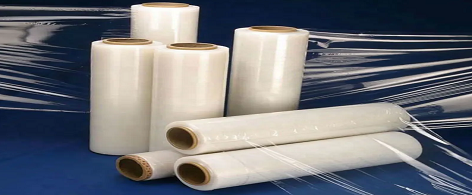Cat:Glue -coated Protective Film
One single flaw is enough to change a “superior” product to “inferior”and thus perfect products need good protection. How you protect your valuable ca...
See Details
1. What is PE stretch film?
PE stretch film is a transparent film made of polyethylene (PE) as the main raw material, which is extruded after heating and melting, and made by cast or blow molding. According to different usage methods, it can be divided into:
Hand Wrap Film: Suitable for manual packaging, usually thinner and easy to use;
Machine Wrap Film: Suitable for automated equipment, with stronger stretching performance and tighter packaging;
Pre-Stretch Film: Pre-stretched, suitable for saving film materials and reducing labor intensity.
Stretch film is often used for pallet wrapping to fix goods, prevent dust and water, and prevent transportation displacement. Because of its strong flexibility, good self-adhesion, high transparency and low cost, it is widely used in logistics, e-commerce, manufacturing, warehousing and other industries.
2. Environmental advantages of recyclable PE stretch film
100% recyclability
PE stretch film has a simple structure, usually a single material (LDPE, LLDPE, etc.), without a metal layer or composite coating. Compared with multi-layer composite materials (such as aluminum-plastic film and paper-plastic composite film), which are complicated and difficult to decompose in recycling, PE film is easier to enter the existing plastic recycling chain, achieving waste reduction at the source.
Reduce carbon footprint
Modern PE film can reduce the thickness to less than 10 microns while greatly improving the tensile strength of the film through process optimization and material improvement. At the same packaging strength, less raw materials and energy are used to achieve transportation weight reduction and carbon emission reduction. For example, for a ton of pallet cargo, the use of high-performance thin PE film can reduce the film usage by 20%-30%.
Resource recycling
After being recycled, waste PE stretch film can be re-crushed, granulated and used to produce recycled plastic products, such as garbage bags, shopping bags, recycled films, gardening plastic products, etc. Some high-purity recycled PE can also be used to make non-food grade packaging films to achieve "closed-loop recycling" of resources.
Reduce business operating costs
In addition to environmental benefits, recycled PE film also brings economic benefits:
Reduced waste disposal costs;
Film materials with recycling value can be sold to recyclers;
Enterprises using recycled PE film can also obtain green certification or policy incentives to enhance brand value.
3. Practical application cases in sustainable packaging
E-commerce logistics industry
E-commerce warehouses require a large amount of packaging materials to package order goods. Using PE stretch film instead of carton seals and wrapping tape not only saves packaging material costs, but also improves packaging efficiency. For example, platforms such as JD.com and Cainiao are piloting the use of pre-stretched film for packaging to improve packaging consistency and reuse rate.
Manufacturing pallet transportation
In the manufacturing industry, a large number of raw materials and finished products need to be packaged and transported on pallets. The use of high-performance machine-use PE stretch film in conjunction with an automatic packaging machine can ensure that the goods are stable, moisture-proof and anti-fouling. Especially in the transportation of automotive parts, building materials, and electrical appliances, PE film greatly reduces the packaging waste caused by the use of traditional strapping tapes and wrapping ropes.
Retailer supply chain optimization
Retail chains such as Walmart and IKEA are promoting green supply chain policies, requiring suppliers to use identifiable and recyclable PE stretch films and affix environmental protection labels for classification and processing at recycling stations. This shift makes the entire supply chain more traceable and environmentally compliant.
4. Challenges and development prospects
Although recyclable PE stretch films have great advantages in environmental protection, their promotion still faces the following practical problems:
Imperfect recycling system
Many countries and regions have not yet established a complete recycling channel for PE films. PE films are large in size, light in weight, and have high transportation costs. If mixed with other waste, they are easily discarded or incinerated by mistake and cannot enter the recycling chain.
Quality perception bias
Some companies and consumers have prejudices against recycled materials, fearing that their quality is not as good as that of virgin materials. In fact, modern recycled PE technology has been able to achieve stable physical properties and is suitable for non-food contact scenarios.
Price fluctuations and dependence on raw materials
The market price of recycled PE is greatly affected by crude oil prices and supply and demand, resulting in companies facing the risk of cost fluctuations when purchasing recyclable films.
Some regions have not yet introduced clear environmentally friendly packaging standards or incentives, and there is a lack of external pressure to push companies to switch to environmentally friendly packaging materials.